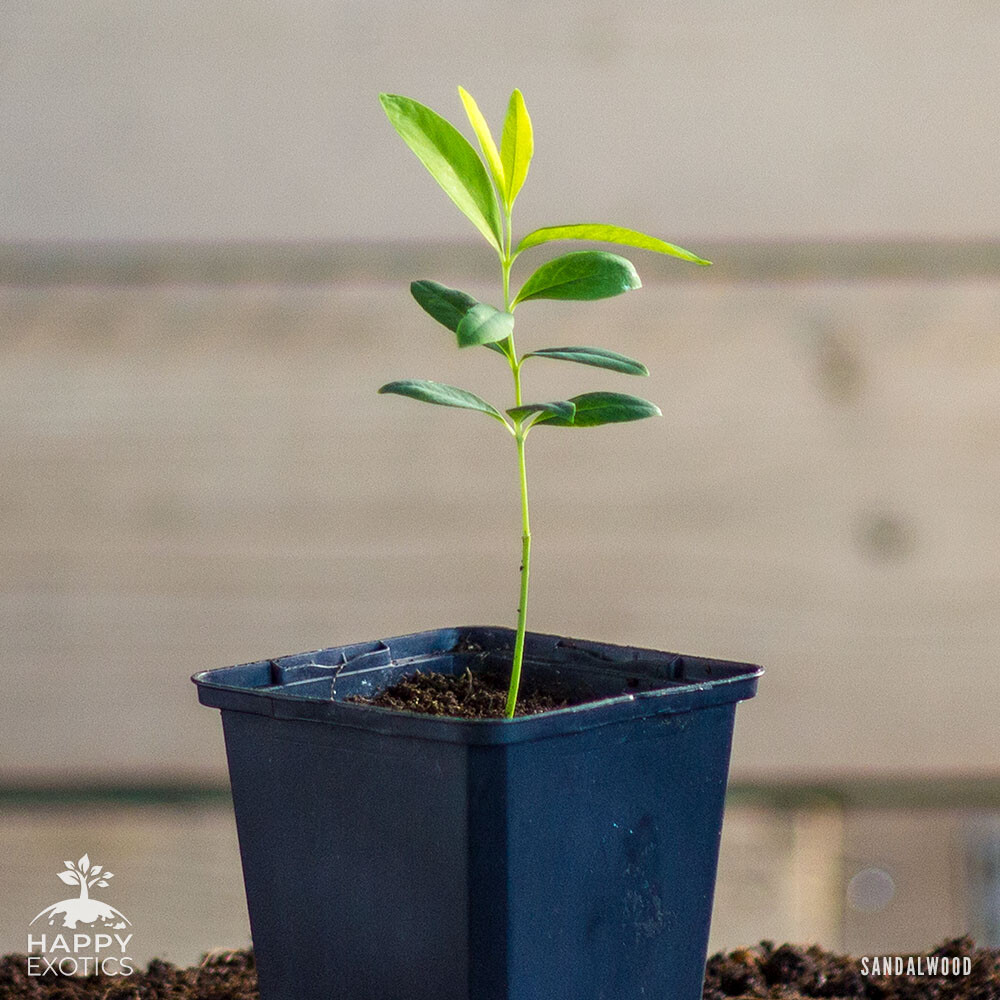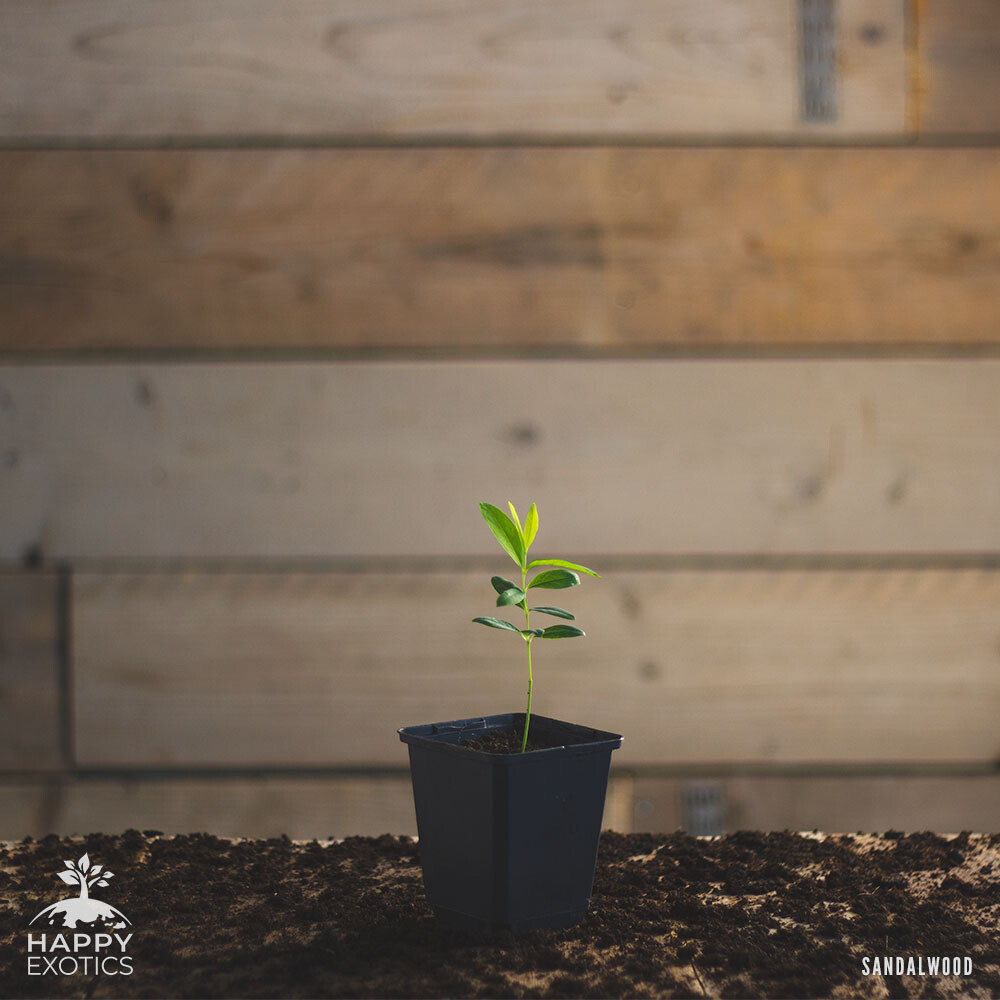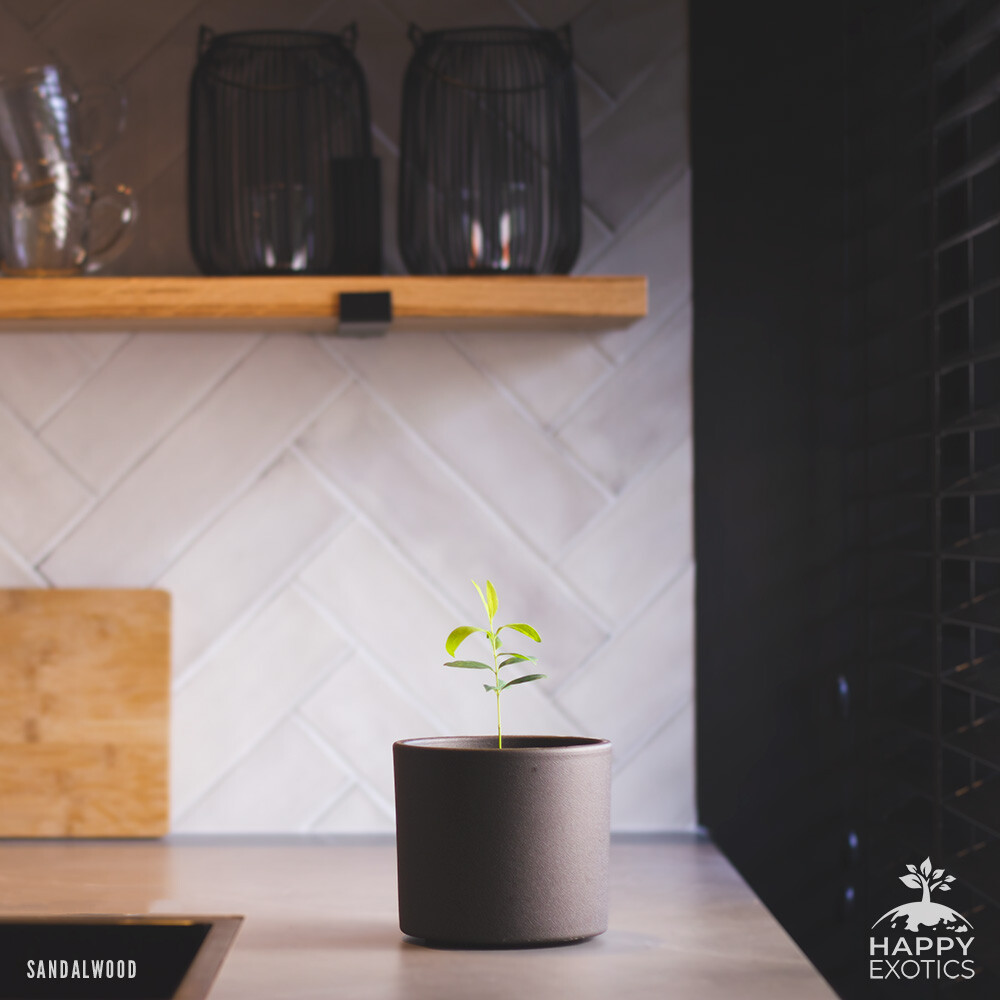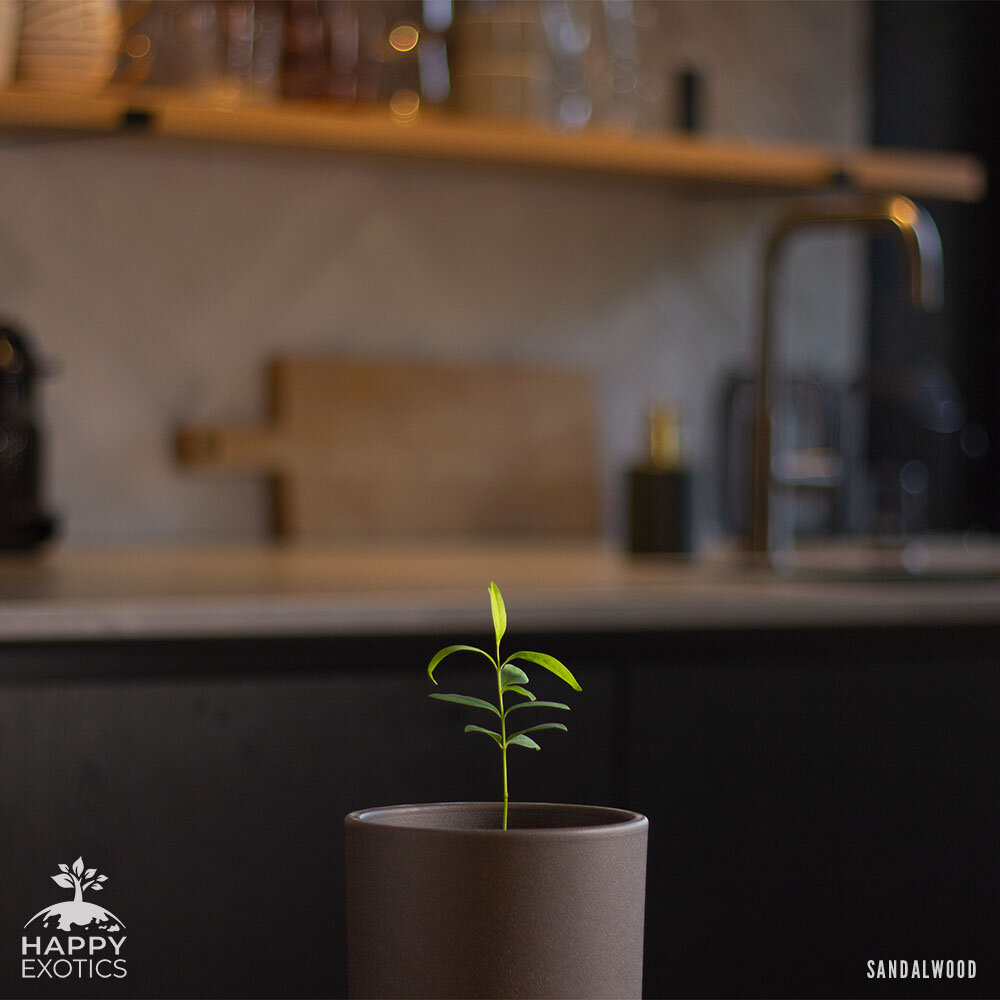1 albero di sandalo super felice - Santalam Album
€24.95
Esaurito
Invia un'e-mail quando le scorte sono disponibili

Spedizione rapida nell'UE

Coltivato nel nostro vivaio
Il sandalo, scientificamente noto come Santalum album, è un albero sempreverde di medie dimensioni appartenente alla famiglia delle Santalaceae. È originario del subcontinente indiano, in particolare dell'India, e si trova anche in alcune zone del sud-est asiatico, tra cui Indonesia e Sri Lanka.
Gli alberi di sandalo hanno un aspetto caratteristico, con un tronco dritto e una chioma densa e simmetrica. Possono raggiungere un'altezza di 8-12 metri e hanno una durata di vita di circa 60-80 anni. La corteccia dell'albero è liscia e di colore grigio-marrone.
L'albero del sandalo è molto apprezzato per il suo profumato durame e ha numerosi usi. Ecco alcuni dei principali usi del sandalo:
- Profumo e fragranza: Il sandalo è noto per il suo aroma dolce e legnoso. Il durame viene distillato per estrarre l'olio essenziale di sandalo, ampiamente utilizzato in profumi, colonie e altri prodotti di fragranza.
- Incenso e pratiche spirituali: Il sandalo viene bruciato come incenso in varie pratiche religiose e spirituali. Si ritiene che la sua fragranza ricca e rilassante favorisca il rilassamento, la meditazione e la concentrazione.
- Usi medicinali e ayurvedici: Il sandalo ha una lunga storia di utilizzo nella medicina tradizionale, in particolare nell'Ayurveda. Si ritiene che abbia proprietà rinfrescanti, antinfiammatorie e antisettiche. La pasta o l'olio di sandalo sono utilizzati per le condizioni della pelle, per l'aromaterapia e per promuovere il benessere mentale.
- Cosmetici e prodotti per la cura della persona: Il sandalo è utilizzato nell'industria cosmetica per il suo profumo e le sue proprietà benefiche. Si trova in saponi, lozioni, creme e vari prodotti per la cura della pelle.
- Artigianato del legno e intaglio: La natura a grana fine e resistente del legno di sandalo lo rende molto ricercato per la lavorazione del legno e l'intaglio. Viene utilizzato per creare intricati intagli, sculture, mobili e oggetti decorativi.
- Cerimonie e rituali tradizionali: Il legno di sandalo è considerato sacro in molte culture e viene utilizzato in cerimonie religiose, rituali e festival. Viene utilizzato sotto forma di polvere di sandalo, pasta o bastoncini d'incenso.
L'albero del sandalo ha foglie piccole e ovali, di colore verde scuro e di consistenza coriacea. Produce fiori piccoli e poco appariscenti, di colore giallo pallido o violaceo. Questi fiori lasciano il posto a piccoli frutti sferici che contengono un unico seme.
A causa dell'elevata domanda di sandalo e di pratiche di raccolta non sostenibili, molte popolazioni di sandalo si sono notevolmente impoverite e la specie è ora considerata minacciata nel suo habitat naturale. Per proteggere e ripristinare le popolazioni di sandalo si stanno attuando sforzi di conservazione e pratiche di coltivazione sostenibili.
Informazioni aggiuntive
| Peso | 0.4 kg |
|---|---|
| Dimensioni | 32 × 17 × 10 cm |
Proprietà e cura
Come prendersi cura di un albero di sandalo?
Crescere un albero di sandalo in vaso può essere un compito impegnativo, poiché gli alberi di sandalo preferiscono crescere nel loro habitat naturale. Tuttavia, se siete disposti a provarci, ecco alcune linee guida generali:
- Scegliete un vaso e un terriccio adatti: Scegliete un vaso grande con buoni fori di drenaggio per consentire la fuoriuscita dell'acqua in eccesso. Utilizzate un terriccio ben drenante composto da una combinazione di sabbia, terriccio e materia organica. Il terreno dovrebbe essere leggermente acido per riprodurre le condizioni naturali che il sandalo predilige.
- Irrigazione e cura: Mantenere il terreno umido, ma senza ristagni d'acqua. Evitate le innaffiature eccessive, che possono provocare il marciume delle radici. Innaffiate e nebulizzate regolarmente per mantenere i livelli di umidità, poiché gli alberi di sandalo preferiscono un ambiente umido. Tuttavia, lasciate che il terreno si asciughi leggermente tra un'annaffiatura e l'altra per evitare i ristagni d'acqua.
- Temperatura e luce solare: Come la maggior parte delle i nostri alberi e le nostre pianteGli alberi di sandalo sono subtropicali e crescono in climi caldi. Fornite al vostro albero di sandalo in vaso un'ampia illuminazione solare, preferibilmente in una posizione che riceva un'ombra parziale. Proteggetelo dalle temperature estreme, dal gelo e dai venti forti.
- Potatura e concimazione: Potare l'albero di tanto in tanto per mantenerne la forma e rimuovere eventuali rami morti o danneggiati. Utilizzare un fertilizzante bilanciato specifico per piante legnose per favorire una crescita sana.
- Pazienza e cure a lungo termine: La coltivazione del sandalo in vaso richiede pazienza, poiché possono essere necessari diversi anni prima che l'albero raggiunga dimensioni adeguate. Assicuratevi una cura costante, che comprenda un'adeguata annaffiatura, la concimazione e il monitoraggio di eventuali parassiti o malattie.
Ricordate che gli alberi di sandalo hanno una crescita lenta e la coltivazione in vaso può risultare difficile.
FAQ
Propagazione
Gli alberi di sandalo possono essere propagati attraverso semi, talee di fusto, colture di tessuti e innesti. I semi sono difficili da far germogliare, mentre le talee e la coltura dei tessuti sono metodi più affidabili. L'innesto consente di produrre piante geneticamente identiche. Per una propagazione di successo è consigliabile rivolgersi a esperti.
Spedizione e restituzione
GARANZIA E RESI
Nonostante l'alta qualità dei nostri prodotti, può capitare di ricevere un prodotto non perfetto. Se ciò dovesse accadere, saremo lieti di fornirvi una soluzione adeguata nel più breve tempo possibile.
SEMPRE 2 ANNI DI GARANZIA
Siamo convinti della qualità dei prodotti che offriamo. Per questo motivo forniamo sempre una garanzia di 2 anni su tutti i vostri acquisti.
PERIODO DI RIMBORSO DI 14 GIORNI
Curryelaftree.com applica un periodo di approvazione e ispezione di 14 giorni per tutti gli ordini online. Questo periodo inizia quando si riceve il prodotto. Dopo 14 giorni il contratto di acquisto diventa definitivo. Durante questo periodo è necessario maneggiare con cura il prodotto e l'imballaggio, se ragionevolmente possibile. Provare il prodotto nella misura necessaria per decidere se tenerlo o meno. Il prodotto può essere visionato e recensito, come si farebbe in un negozio. In caso di danni al prodotto o all'imballaggio, questi verranno detratti dalla restituzione. Se il prodotto è stato utilizzato in questo periodo e poi restituito, i costi di utilizzo, come i costi di pulizia o di riparazione, saranno detratti dal reso. Quando si restituisce un prodotto entro il periodo di rimborso di 14 giorni, siamo obbligati a rimborsare il prezzo di acquisto, comprese le spese di spedizione ed eventuali costi di addebito o di amministrazione, entro 14 giorni dal ricevimento del reso.
DANNI AL RICEVIMENTO
Tutti i prodotti sono imballati in modo sicuro e controllati da Curryleaftree.com prima della spedizione. Se tuttavia si riceve un prodotto danneggiato, si prega di segnalare il danno prima di restituire l'ordine.
RESTITUISCE LA PROCEDURA
Ci sono diversi motivi per cui potreste decidere di restituire (una parte) del vostro ordine. Leggete attentamente queste informazioni per evitare malintesi e ritardi. Se si desidera restituire un prodotto, il metodo di spedizione e le condizioni del prodotto devono essere conformi ai nostri termini e condizioni indicati di seguito.
Modulo di restituzione
Per la restituzione di una spedizione contattateci prima. Compilando un modulo e inviandocelo, ci comunicate che volete restituire la vostra spedizione. Una volta ricevuto il modulo, inizieremo a elaborare il vostro reso. Potete sempre inviarci un'e-mail per discutere del vostro ritorno.
Spedizione di ritorno e costi
Le spese di affrancatura postale corrette devono sempre essere pagate per una spedizione di ritorno. I pacchi non correttamente affrancati o contrassegnati come resi soggetti a pagamento alla consegna non saranno accettati da noi. Curryleaftree.com rimborsa le spese postali di restituzione nel caso in cui la restituzione sia il risultato di un errore di Curryleaftree.com o di un prodotto difettoso. Se avete diritto al rimborso delle spese di spedizione, applichiamo una tariffa massima. Potete anche scegliere di riportare il prodotto o di cambiarlo presso l'ufficio di Curryleaftree.com. Si tratta di un'operazione rapida, semplice e gratuita. La tariffa massima per una spedizione di ritorno è di € 6,95 nei Paesi Bassi, € 9,95 per Belgio e Germania, € 25,95 per il resto d'Europa e € 29,00 per il resto del mondo.
Indirizzo di ritorno
Curryleaftree.com
Garanzia e restituzione
Tolweg 2W 3851 SK
Ermelo Paesi Bassi
Solamente clienti che hanno effettuato l'accesso ed hanno acquistato questo prodotto possono lasciare una recensione.





Recensioni
Ancora non ci sono recensioni.